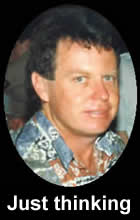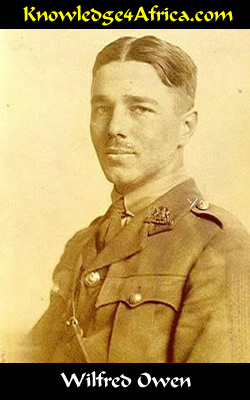|
READ THIS
Owen is a renowned anti-war poet. All his poems are set in the trenches of the Great War (1st
World War) and each aims to show through the use of shock images how grotesque and
inhuman warfare really is.
Owen himself fought in the trenches but, ironically, was killed just one week before the end of
the war in 1918.
 ABOUT THE POET
ABOUT THE POET
Wilfred Owen was born in 1893 in Shropshire to a family of committed Christians. He was
educated at the Birkenhead Institute and Shrewsbury Technical College.
He wanted to become a teacher but his father could not afford the university fees. Instead,
therefore, he journeyed to France in 1913 where he worked as a tutor. He also wrote
occasional poetry, none of which is particularly known.
When the Great War broke out in 1914, Owen maintained a vague interest in events through
cuttings from newspapers sent by his mother with whom he had a close relationship.
Eventually, however, the pressure of propaganda reached him and, in October 1915, he
returned to England and enlisted. He was then 22 years of age.
The poet spent a year in training. Letters to his mother reveal that he enjoyed the prestige of
wearing the military uniform. His training finished at the end of 1916 whereupon he joined the
2nd Manchesters in France where he took command of No. 3 Platoon.
His enthusiasm initially abounded but soon he was sent to the frontline and witnessed firsthand
the awfulness of warfare -- living in trenches which were forever knee-deep in mud and water,
the rotting corpses of soldiers, the dreadful war injuries.
"I have suffered seventh hell," he wrote to his mother. "I have not been at the front.
I have been in front of it . . . to where the ground was not mud, not sloppy mud, but
an octopus of sucking clay, three, four, and five feet deep, relieved only by craters full of
water . . . "
Initially Owen's character and temperament did not suit his being a soldier. He was a scholar
and a poet -- introverted and sensitive. Moreover, he was a committed Christian whose ideals
were opposed to warfare in any form. It was during this period that he appears to have penned
most of his anti-war poems.
The war forced him to face a conflict between his Christian beliefs and his role as a soldier.
"I am more and more a Christian," he wrote to his mother in May 1917. "Suffer
dishonour and disgrace, but never resort to arms. Be bullied, be outraged, be killed: but do not
kill."
Late in 1917 Owen received a serious injury and was sent home, suffering from shell-shock.
While recuperating in the military hospital, he fell under the influence of the anti-war poet,
Siegfried Sassoon, who aided him in polishing his war poetry.
Yet Owen appears to have had a distinct dislike for pacifists and did not want to be identified
with them. Indeed, he felt that his poetry could have a far deeper impact if emanating from a
soldier in the trenches.
For that reason, therefore, he re-enlisted for the army and, in October 1918, he rejoined his
company in France. This time, however, he appears to have identified himself with the soldiers
and took tremendous risks in battle.
During one encounter, he captured a German machine gun and used it to decimate a host of
enemy soldiers, for which deed he won the Victoria Cross. Although he denied it in letters to
his mother, he appears now to have become a killing machine.
In early November, just one week before the armistice which ended the war, he supervised the
construction of a bridge to cross the Sambre and Oise Canal. Wave after wave of his own men
were massacred in the attempt. Wilfred Owen too fell in a flurry of machine gun bullets.
He was buried in a small British cemetery in northern France. He was then just 25 years of
age.
Have you looked at the questions
in the right column?
|
TEST YOURSELF!
Read the left column and then answer
the following questions:
"What passing-bells for these who die as cattle?
Only the monstrous anger of the guns.
Only the stuttering rifles' rapid rattle
Can patter out their hasty orisons."
- What do the "doomed youth" have in common with cattle? (4)

[Need help?]
Cattle are bred mostly to be slaughtered. They have no control whatever over their lives and
there is no emotion when they die.
Owen's simile is therefore a particularly rich one -- young soldiers being sent off to warfare in
the prime of their lives, and doomed to be slaughtered with no concern for their well-being.
|
- Identify and name THREE language devices used in the lines: "Only the stuttering rifles'
rapid rattle | Can patter out their hasty orisons." (6)

[Need help?]
"rifles' rapid rattle" = alliteration;
"stuttering" and "patter" = onomatopoeia;
"their hasty orisons" = personification.
|
- In what way could the "rifles rapid rattle" be compared to the soldiers "hasty
orisons"? (4)

[Need help?]
Owen's imagery is particular graphic. The rifles are stuttering (in fear?), pattering out their
bullets like thousands of tiny prayers. (You need to have witnessed the really rapid prayers
prayed by priests of the Anglican or Catholic denominations back in those days to realise just
how good a comparison this is!)
The combination of alliteration and onomatopoeia allows one to hear the sound of the bullets
being fired off and pattering into the earth walls of the trenches.
|
"No mockeries now for them; no prayers nor bells;
Nor any voice of mourning save the choirs, -
The shrill, demented choirs of wailing shells;
And bugles calling for them from sad shires."
- What is meant by "these mockeries"? (4)

[Need help?]
There was no conscription during the 1st World War (or what used to be known as the
"Great War"). However, moral and psychological pressure was brought to bear on
young men to force them to join the army. The chief pressure was to mock the men who had
not enlisted.
One such way was to send them a white feather which represented cowardice. Women whose
husbands / children / boyfriends had joined up to fight would mock those who hadn't by sending
them a white feather of cowardice.
|
- Why does the poet say that there will be no more "mockeries" for the
soldiers? (2)

[Need help?]
Once the soldiers were dead, all mockery then ceased for them. The poet himself detested
warfare but felt forced to enlist. It is ironic that he was killed in battle just one week before the
end of the war!
|
"What candles may be held to speed them all?
Not in the hands of boys, but in their eyes
Shall shine the holy glimmers of good-byes.
The pallor of girls' brows shall be their pall."
- The poet says that no candles will be lit at the funerals of these soldiers. Instead, he says,
"in their eyes | Shall shine the holy glimmers of good-byes". What does he mean by
this? (4)

[Need help?]
The soldiers die suddenly, but their eyes remain open. The light of the sky will then reflect dully
from these open eyes. It is traditional to close the eyes of the dead but on the battlefield there
are so many dead soldiers that no-one has time to do so. Therefore the light gleams off their
open eyes like so many dull candles.
|
- What is meant by the words, "The pallor of girls' brows shall be their
pall"? (2)

[Need help?]
A pall is a cloth that is draped over a coffin. It could be any colour but the poet wishes it to be
white in this sonnet. He says, however, that there will be no coffin or pall for the dead soldiers.
Their only pall will be the white faces of the women back home, shocked at the news of the
death of their loved ones.
|
In this sonnet, the poet provides six images which contrast the death of soldiers in war with the
burial of civilians in a traditional funeral.
- Using a grid with one column marked, "Traditional Church Funeral", and a second
marked, "Wartime Battlefield Funeral", show clearly what are the main points that he
compares? (6)

[Need help?]
1. The Church bells are replaced by the booming of the heavy guns being fired;
2. Prayers are replaced by the rapid rattle of the automatic weapons;
3. The Church Choirs are replaced by the whining of the shells overhead;
4. The Candles held by the altar boys are replaced by the light gleaming off the soldiers' dead
eyes;
5. The Pall or white cloth draped over the coffin is replaced by the white faces of the females
back home who had just heard the shocking news of the death of their loved ones;
6. Flowers are replaced by the kind thoughts of those back home.
|
"Their flowers the tenderness of patient minds,
And each slow dusk a drawing-down of blinds."
- Name TWO language devices used in these two lines. Be able to explain your
answer. (4)

[Need help?]
In "dusk a drawing-down" you will find alliteration.
The two lines also contain a metaphor which compares the soldier's life to the passing of day.
The death of the soldier is therefore like the coming of darkness at the end of the day, a time
when the curtains are traditionally closed.
|
|



